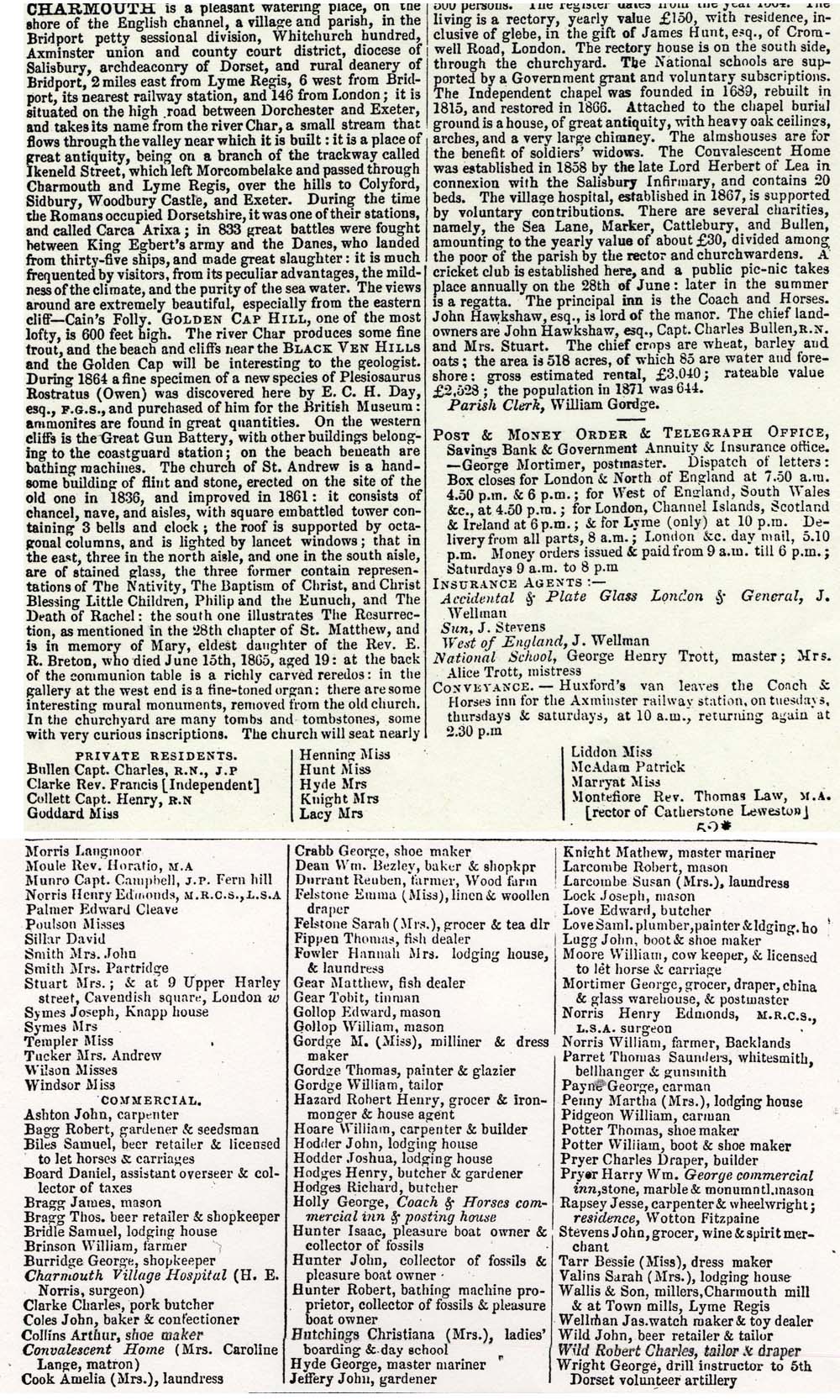1875 Directory for Charmouth

Charmouth is a pleasant watering place, on the shore of the English channel, a village and parish in the Bridport petty sessional division, Whitchurch hundred, Axminster union and county court district, diocese of Salisbury, archdeaconry of Dorset, and rural deanery of Bridport, 2 miles east from Lyme Regis, 6 west from Bridport, irs nearest railway station, and 146 from London; it is situated on the high road between Dorchester and Exeter, and takes its name from the river Char, a small stream that flows through the valley near which it is built: it is a place of great antiquity, being on a branch of the trackway called Ikeneld Street, which left Morcombelake and passed through Charmouth & Lyme Regis, over the hills to Colyford, Sidbury, Woodbury Castle, and Exeter.
During the time the Romans occupied Dorsetshire, it was one of their stations, and called Carea Arixa;
in 833 great battles were fought between King Egbert's army and the Danes, who landed from 35 ships, and made great slaughter: it is much frequented by visitors, from its peculiar advantages, the mildness of the climate, and the purity of the sea water. The views around are extremely beautiful, especially from the eastern cliff – Cain's Folly.
GOLDEN CAP HILL, one of the most lofty, is 600 feet high. The river Char produces some fine trout, and the beach and cliffs near the BLACK VEN HILLS and the Golden Cap will be interesting to the geologist.
During 1864 a fine specimen of a new species of Plesiosaurus Rostratus (Owen) was discovered here by E.C.H. Day, esq., P.G.S., and purchased of him for the British Museum: ammonites are found in great quantities.
On the western cliffs is the Great Gun Battery, with other buildings belonging to the coastguard station: on the beach beneath are bathing machines.
The church of St. Andrew is a handsome building of flint and stone, erected on the site of the old one in 1836, and improved in 1861: it consists of chancel, nave, and aisles, with square embattled tower containing 3 bells and clock; the roof is supported by octagonal columns, and is lighted by lancet windows; that in the east, three in the north aisle, and one in the south aisle, are of stained glass, the three former contain representations of The Nativity, The Baptism of Christ and Christ Blessing Little Children, Philip and the Eunuch, and The Death of Rachel: the south one illustrates The Resurrection, as mentioned in the 28th chapter of St Matthew, and is in memory of Mary, eldest daughter of the Rev. E. R. Breton, who died June 5th 1865, aged 19: at the back of the communion table is a richly carved raredos; in the gallery at the west end is a fine-toned organ: there are some interesting mural monuments, removed from the old church. In the churchyard are many tombs and tombstones, some with very curious inscriptions. The church will seat nearly 500 persons. The register dates from the year 1564. The living is a rectory, yearly value £150, with residence, inclusive of glebe, in the gift of James Hunt, esq., of Cromwell Road, London. The rectory house is on the south side, through the churchyard.
The National schools are supported by a Government grant and voluntary subscriptions.
The Independent chapel was founded in 1689, rebuilt in 1815, and restored in 1866. Attached to the chapel burial ground is a house, of great antiquity, with heavy oak ceilings, arches and a very large chimney.
The almshouses are for the benefit of soldiers widows.
The Convalescent Home was established in 1858 by the late Lord Herbert of Lea in connexion with the Salisbury Infirmary and contains 20 beds.
The village hospital, established in 1867 is supported by voluntary contributions.
There are several charities, namely, the Sea Lane, Marker, Cattlebury, and Bullen, amounting to a yearly value of about £90, divided among the poor of the parish by the rector and churchwardens.
A cricket club is established here, and a public picnic takes place annually on the 28th of June: later in the summer is a regatta.
The principal inn is the Coach and Horses.
John Hawkshaw, esq, is lord of the manor.
The chief landowners are John Hawkshaw, esq. , Capt.Charles Bullen, R.N. and Mrs Stuart.
The chief crops are wheat, barley and oats; the area is 518 acres of which 85 are water and foreshore: gross estimated rental, £3,840; rateable value, £2,528; the population in 1871 was 644.